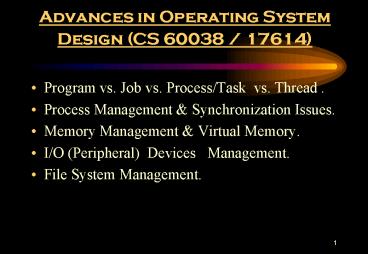Advances in Operating System Design CS 60038 17614 - PowerPoint PPT Presentation
1 / 17
Title:
Advances in Operating System Design CS 60038 17614
Description:
Brief Reviews of basic concept. Role of an ... Shields the basic limitations of the Computer's resources from the user. ... Basic Features of Device Drivers : ... – PowerPoint PPT presentation
Number of Views:20
Avg rating:3.0/5.0
Title: Advances in Operating System Design CS 60038 17614
1
Advances in Operating System Design (CS 60038 /
17614)
- Program vs. Job vs. Process/Task vs. Thread .
- Process Management Synchronization Issues.
- Memory Management Virtual Memory.
- I/O (Peripheral) Devices Management.
- File System Management.
2
Brief Reviews of basic concept
- Role of an Operating System.
- Structural Hierarchical overviews of a typical
Computer System along with System Software
Layers. - Evolution of the Operating System.
3
Role of an Operating System
- General Views.
- Users Views.
- System Designers Views.
4
Role of an Operating System (General Views)
- A piece of Software that helps a computer system
to operate ( A System Software). - The Monitor program that monitors all activities
going on inside the Computer . - A Resource Manager.
- The Man Machine Interface.
5
Role of an Operating System (Users View)
- Accepts commands that make a Computer
act/operate (Input, Store, Process, Output). - Shields the basic limitations of the Computers
resources from the user. - Guarantees Response time for each user command.
- Provides a hospitable user friendly interface.
6
Role of an Operating System(System Designers
View) - 1
- Develop Device Drivers.
- Provide Utility Services like Editors ,
Translators other Applications. - Effective Utilization Management of System
Resources. - Frame a Friendly ( Self explanatory Self
Correcting) user interface.
7
Role of an Operating System (System
Designer View) - 2
- A. Device Driver Programs Helps the devices
to function. - The basic devices that should Operate
- Key board Read.
- Mouse Click.
- V.D.U. Display.
- Disk (Magnetic CD) Read Write.
8
Role of an Operating System(System Designers
View) - 3
- Basic Features of Device Drivers
- Written using Low Level / Low level Features of
a programming language. - Underlying machine / CPU dependent.
- Contained in non-volatile ROMs and / or loaded
from disk(s) on demand (if installed). - Makes the peripheral interfaces to interact with
the CPU in accordance with O.S. Commands.
9
Role of an Operating System (System
Designer View) - 4
- B. Processor /Process Management
- Involves the following tasks
- 1) Managing the single CPU and its
co-processors like Floating Point Units (FPUs)
Multi Media (MMX), Memory Management Units
(MMUs ) Normally handled directly by
Architecture. - 2) Coordinating Several CPUs in a Multiprocessor
System which may be - a) Tightly Coupled.
- b) Loosely Coupled. (Distributed).
10
Role of an Operating System (System
Designer View) - 5
- C. Memory Management
- - Cache (ON Chip OFF Chip) Normally
handled by Architecture . - Main or Primary Memory.
- Secondary Storage Disk (Hard,Floppy) /
CDs /Tape ( To provide virtual storage ).
11
Role of an Operating System (System
Designer View) - 6
- Managing the File System (Information Bank).
- Management Control of the peripheral
Devices associated Interfaces. - Role of the Interfaces
- a) Matching Electrical Characteristics.
- b) Matching Speeds.
12
Processor Management Functions
- Allocate / De-allocate jobs (processes) to
processors - (in accordance with predefined policy).
- Keep track of current status of each process
- as well as the processor(s) .
- Decide on the processor(s) occupancy
period(s). - Ensure guaranteed response time.
- Report any illegal operation(s) and take
corrective - actions.
13
Memory System Management Functions
- Keeping track of memory occupancy.
- (what process resides where and how much)
- Swapping in / out portions of a process
between main memory secondary storage on
requirement. - Ensure availability of enough memory in a
manner transparent to the user. - Create the feeling of the existence of an
infinite sized , high speed memory for any
process.
14
FILE Management Functions
- A function which is mostly used by the users.
- Keeping track of the Secondary Storage (File
Cabinet) . - (which file stored where the directory
structure) - Storage / (Allocation space) for files.
space - De-allocating space for deleted files .
management - Compacting freed space on disk.
- Accessibility control protection (Read,
Write, Execute Access) of files. - Forms the backbone of any Data Base and / or
Information System.
15
Peripheral Device Management Functions
- Installation of device drivers.
- Activating device driver programs on
demand (usually user request). - Allowing the fast paced CPU and the slow paced
/ faster peripheral interface to operate at
their - own speed.
- Guaranteeing availability of peripherals to all
requesting processes without sacrificing
response time. - Enforce proper device sharing protocols if
needed (to make non shareable devices shareable) - Monitoring each active device status.
16
The O.S. System Hierarchy
Command Line Interpreter
Command Line Interpreter
Kernel / Device Drivers
GUI
H/W
E D I T O R
Graphics User Interface (GUI)
User Programs
17
Evolution of Operating System
- Serial .
- Simple Batch.
- Multi programmed Batch.
- Time Sharing/ Multi Tasking.
- Multi Processing ( Parallel Distributed).































